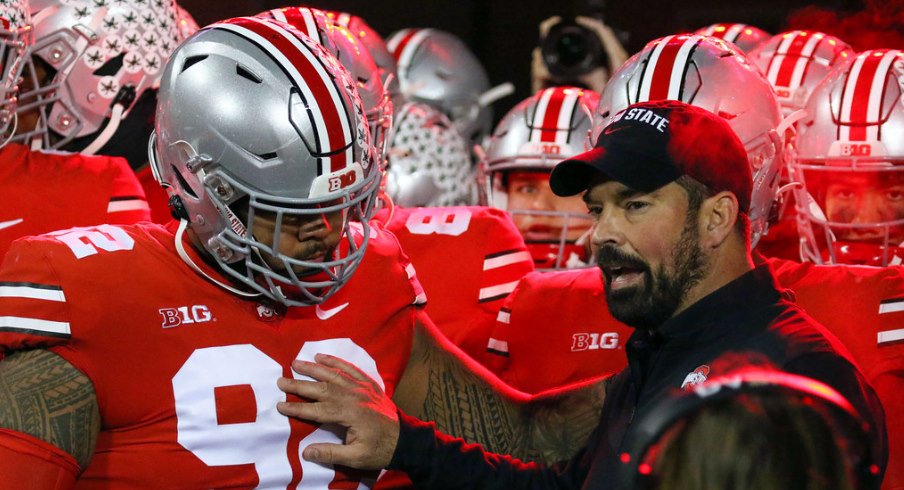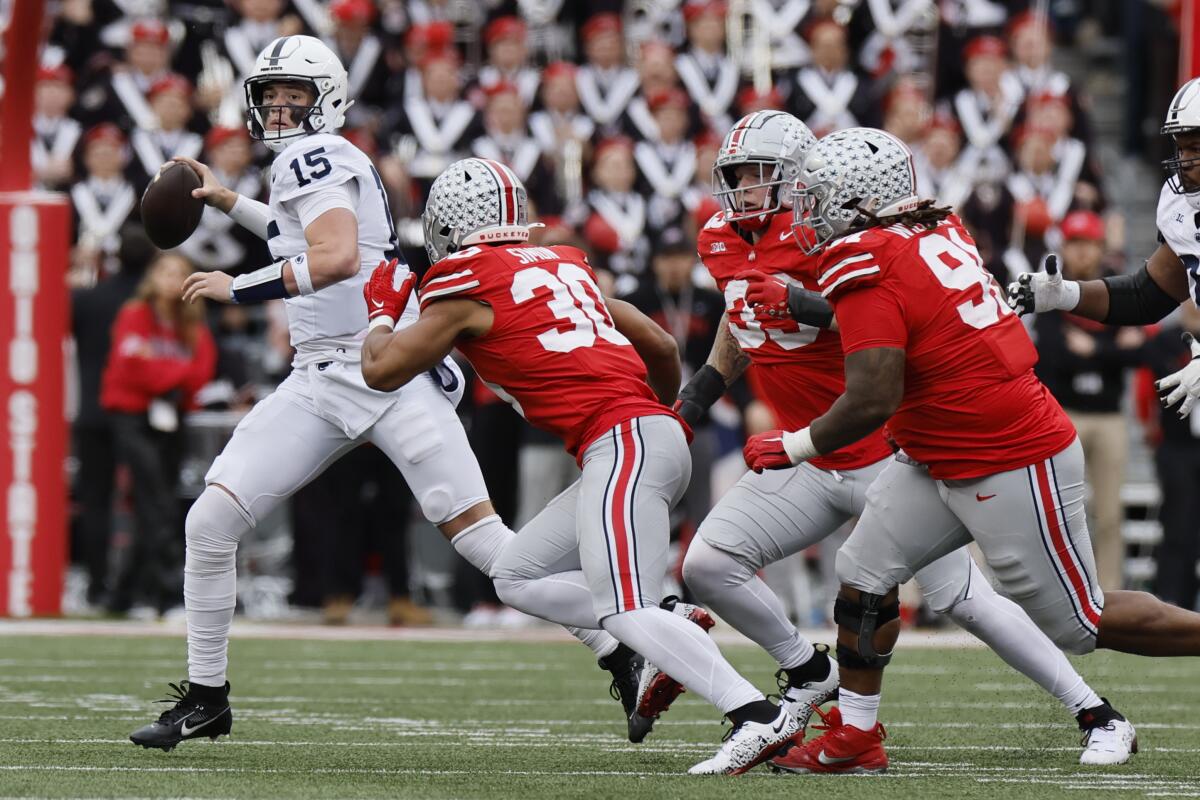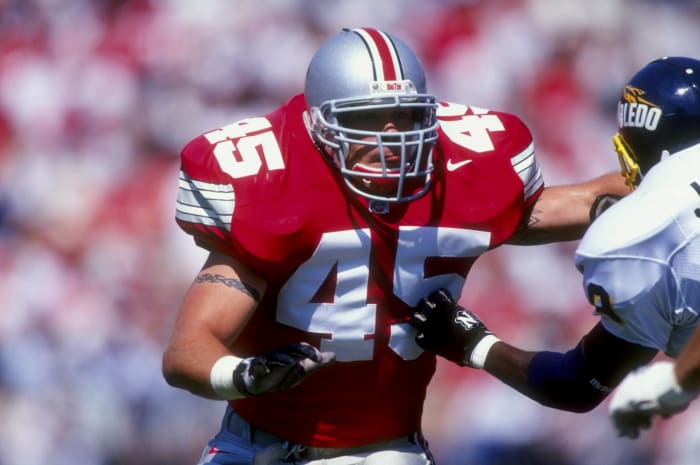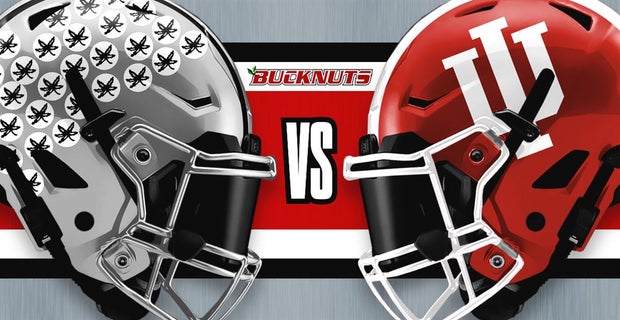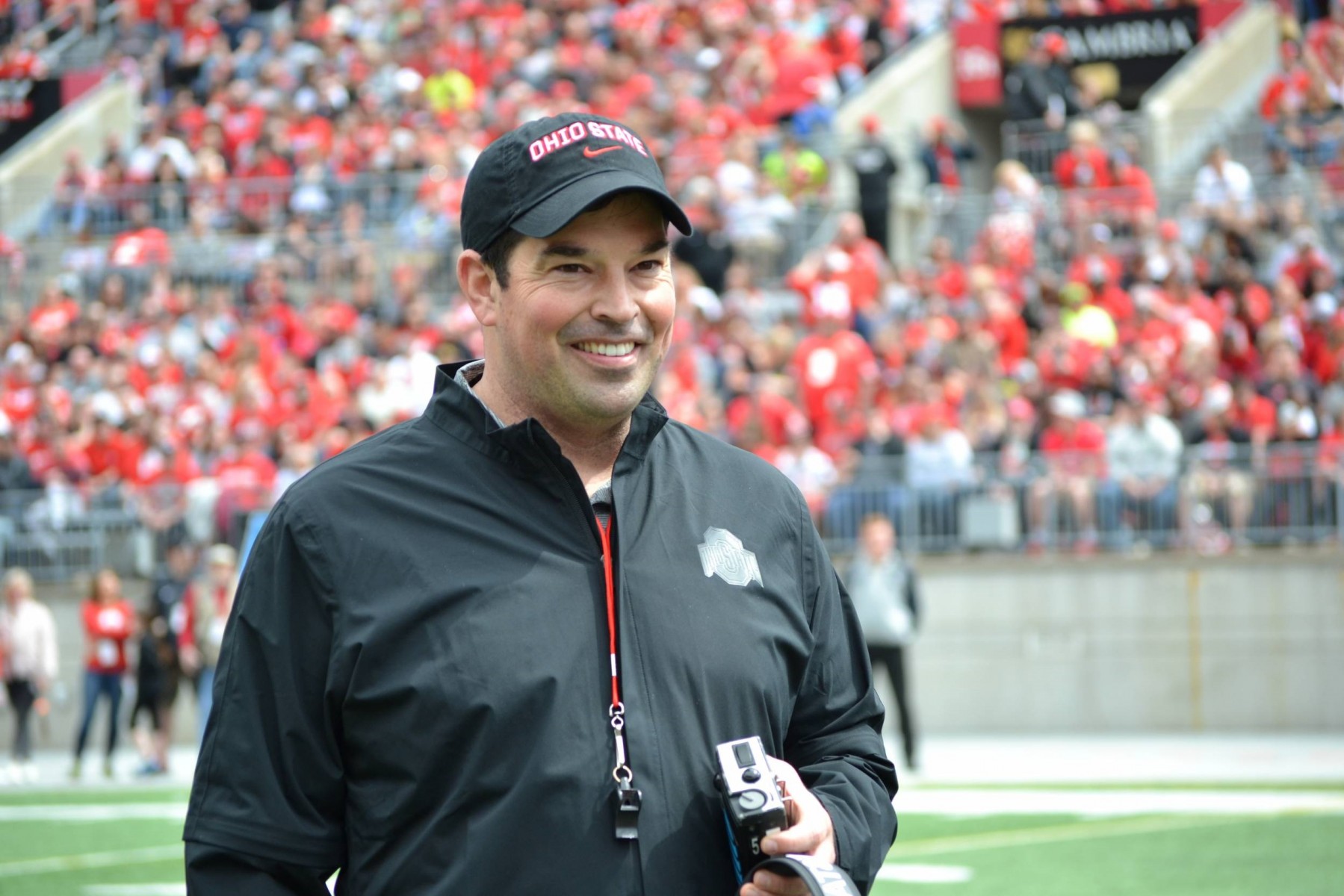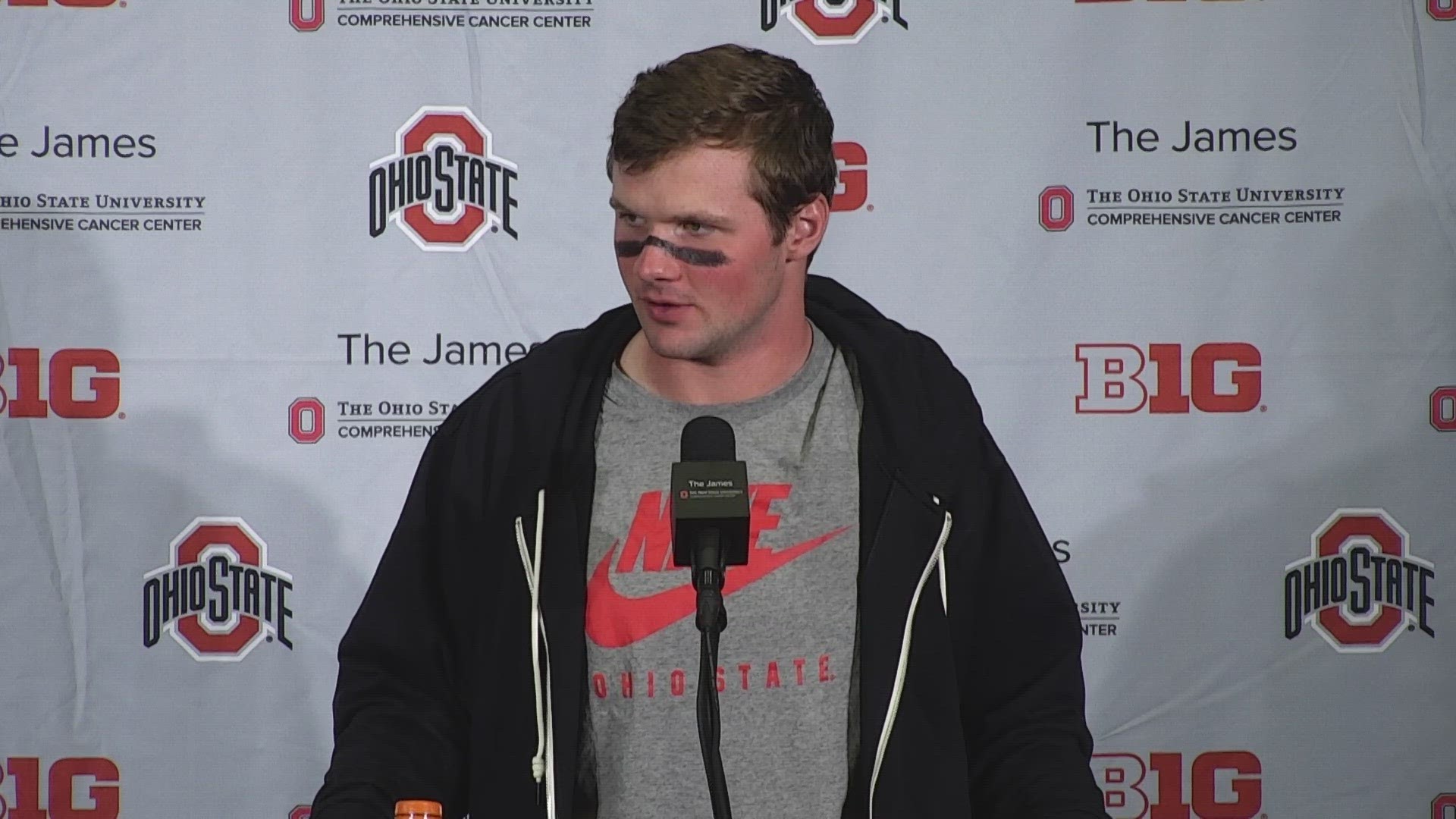A perennial college football power, Ohio State continues to churn out of some of the greatest players in the history of the sport.
And, the Buckeyes seem to get even better talent as the years add up.
Here are our choices for the greatest players in Ohio State football history. Listed in chronological order.
One of the first players to truly bring Ohio State football to the forefront. Where it’s stood for more than a century. Harley, who totaled 201 points in 24 career games, interrupted by his stint as a pilot in World War I, with the Buckeyes, is noted as the school’s first consensus All-American and an early inductee into the College Football Hall of Fame. Harley also led the way during Ohio State’s first victory over arch-rival Michigan in 1919.
The first Ohio State football player to win the prestigious Heisman Trophy. Horvath took home that particular piece of hardware in 1944 when he returned to the Buckeyes team following a year off while studying in the university’s College of Dentistry. That season, Horvath rushed for nearly 700 yards and amassed 1,200 all-purpose yards. He was also named an All-American and Big Ten Conference Most Valuable Player in 1944.
A three-year starter for the Buckeyes, the Columbus, Ohio-native was a two-way standout and key member of the 1942 national championship squad at Ohio State. Though Willis wasn’t one of the biggest talents to work in the trenches (6-foot-2, 210 pounds), he was a smart and physically gifted athlete, who played with a high motor. Willis was inducted into the College Football Hall of Fame in 1971, and the Pro Football Hall of Fame six years later.
Six years after Les Horvath won the Heisman Trophy at the Ohio State, Janowicz was honored with the award. During the 1950 season, Janowicz was the Buckeyes’ star ball-carrier, rushing for 314 yards. He also threw for 561 and accounted for 17 touchdowns. Horvath also starred as a safety on the other side of the ball and was Ohio State’s punter. It was a rarity when Janowicz actually left the football field.
Old-school football fans probably better know Cassady by his popular nickname — “Hopalong.” Cassady was the third Ohio State player to win the Heisman Trophy, claiming the honor in 1955. The versatile and multi-talented Cassady totaled 37 touchdowns in 36 games and was part of the Buckeyes’ undefeated 1954 national championship squad. A College Football Hall of Famer, Cassady had his No. 40 retired by the school.
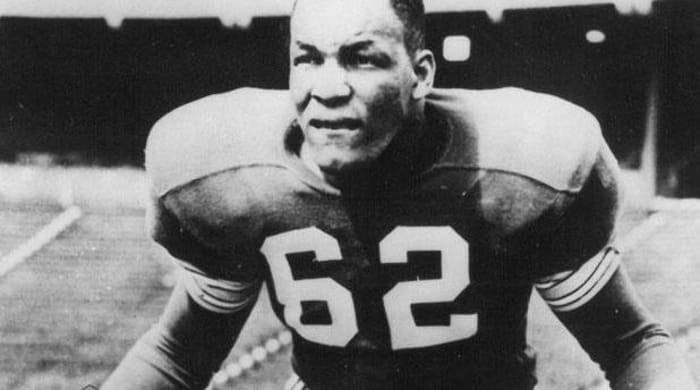
While Bill Willis made up for his lack of overall size and stature with a ruthless tenacity, Parker has giant when placed among fellow linemen of the day. At 6-3, 273 pounds, Parker has long been considered one of the most complete offensive linemen in college football history. He helped pave the way for the likes of “Hopalong” Cassady to churn out yard after yard on the ground and was an integral part of Ohio State’s 1954 national championship team.
Before Tatum endured a successful, yet infamous, NFL career, he cut his teeth as one of the college game’s best defensive backs while at Ohio State. During the late 1960s and into the early ’70s, Tatum fine-tuned his hard-hitting ways as a three-year starter for the Buckeyes. He helped Ohio State win the 1968 national championship, was named a two-time All-American, and tabbed college football’s National Defensive Player of the Year in 1970.
Not only is Griffin the greatest player in Ohio State football history, but perhaps ever in all of the college game. For starters, he’s only the player ever to win the Heisman Trophy twice — in 1974 and ’75. He’s a three-time All-American and the only player to start in four Rose Bowl games. Griffin’s 5,589 career rushing yards are still the most in Ohio State history, while his 924 carries are also an all-time school record. Somewhat surprising, Griffin only recorded 26 rushing touchdowns — 12 of which came in 1974.
The beloved Cousineau was part of three Big Ten championship-winning teams during his tenure at Ohio State. A two-time All-American for the Buckeyes, Cousineau ranks second all-time in Ohio State history with 569 tackles. His 211 tackles from 1978, are the most by an Ohio State player for a single season. While his 29 tackles versus Penn State from that same season are also a school record for a single game. Cris Carter, Wide Receiver (1984-’86)

Carter has the distinction of being the first Ohio State wide receiver to earn All-American honors. From the start, Carter made a lasting impression at Ohio State, and his nine receptions in the Rose Bowl his freshman season were a record — to go along with 172 yards. Though Carter’s collegiate career with the Buckeyes ended on a sour note when he was ruled ineligible for his senior season after signing with an agent, his 2,725 career receiving rank fourth in school history, and his 27 touchdowns are fourth.
The story goes, Spielman, one of the top high school players in the country, wanted to play college football at Michigan. However, his father, a devote Buckeyes fan, wouldn’t allow it. Chris ended up at Ohio State, where he was a two-time consensus All-American and the 1987 Lombardi Award winner. Spielman ranks third all-time in school history with 546 tackles, while his 29 recorded against the rival Wolverines in 1986 are tied for most in a single Ohio State game.Eddie George, Running Back
The 1995 winner of the Heisman Trophy, George ranks fourth in Ohio State history with 3,768 rushing yards. His 1,927 yards from that stellar 1995 campaign are the second-most all-time for a single season in school history. George possessed the perfect blend of size and speed and had no trouble carrying the load. His 683 rushing attempts rank third among all Buckeyes. In addition to the Heisman, George won the Doak Walker, Maxwell, and Walter Camp Awards.
Before Vrabel enjoyed strong NFL careers as a player and coach, he made history as one of the most fierce defenders in the annals of Ohio State football. A two-time Big Ten Defensive Lineman of the Year (1995, ’96), Vrabel is also the Buckeyes’ career record holder with 36 sacks. His 13 sacks in 1995, and 12 from a year earlier, rank Nos. 4 and 5 (tied) in school history, respectively, for a single season.
Orlando Pace, Offensive Lineman (1994-’96)

A seven-time NFL Pro Bowler and Super Bowl champion, Pace is often considered the best offensive lineman in the history of the league. It actually began at Ohio State, where Pace became the second true freshman to start the first game of the season. A two-time consensus All-American, the mammoth Pace won the Lombardi Award in 1995 and ’96 and was the Outland Trophy winner during the latter season. He was the NFL’s overall No. 1 draft pick in 1997.
David Boston, Wide Receiver (1996-’98)

Boston might not have had the exemplary NFL career that many expected, but maybe that’s because he made things look so easy on the collegiate level. A two-time first-team All-Big Ten performer and All-American first-teamer in 1998, Boston is Ohio State’s second-leading receiver with 2,855 career yards. The 1,435 he recorded in 1998 are still the most in one season by a Buckeye. Boston’s 34 career touchdowns are No. 1 at Ohio State and his 191 receptions are second all-time.
Andy Katzenmoyer, Linebacker (1996-’98)
The “Big Kat” was as tough as they come. Yet, it seems as the years go on, he hasn’t received his due among other great defenders in Ohio State history. The co-Big Ten Freshman of the Year, Katzenmoyer recorded 256 tackles, 50 for loss, 18 sacks, and six interceptions during his career at Ohio State. He was a three-time first-team All-Big Ten selection and won both the Butkus Award and Jack Lambert Award for his play during the 1997 season.
A.J. Hawk, Linebacker (2002-’05)
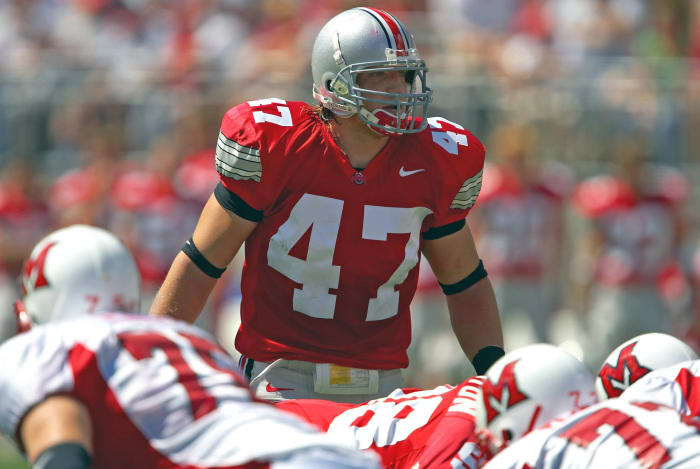
In the mold of an Andy Katzenmoyer, Hawk never seemed to stop when on the field. Relentless in his pursuit of the ball-carrier, Hawk finished his Buckeyes’ career with 294 tackles — ranking fifth in school history. The two-time consensus All-American helped Ohio State to a national championship in his first season and ended his collegiate run in 2005 by being honored as Big Ten Defensive Player of the Year and winning both the Lombardi Award and Jack Lambert Trophy.
Troy Smith, Quarterback (2002-’06)

Smith might be the most forgotten of Ohio State’s six individual Heisman winners. Perhaps because his football success was essentially limited to the college game. It can be argued that Smith began the trend of versatile, multi-threat quarterbacks that have become a recent staple at Ohio State. In 2005, Smith passed for 2,282 yards with 16 touchdowns and ran for 611 with 11 scores. The next season, Smith was the nation’s top player, throwing for 2,542 yards with 30 TDs and running for 576 with seven scores for a 12-1 Buckeyes squad that lost to Florida in the national championship game. Smith ranks sixth in Ohio State history in both total offensive yards (6,888) and touchdowns (68).
Malcolm Jenkins, Defensive Back (2005-’08)
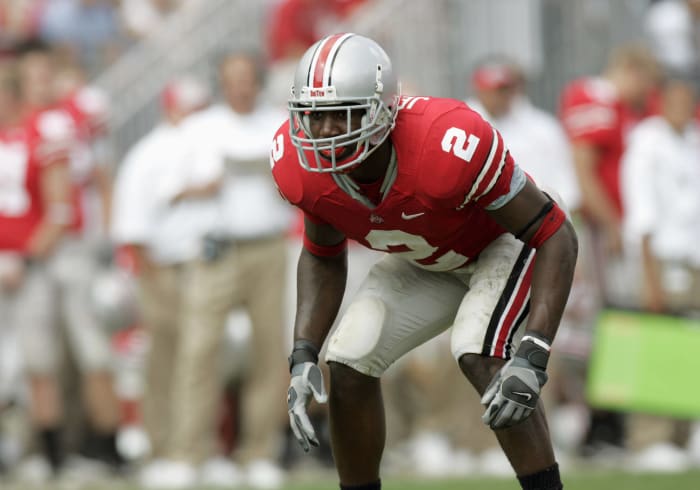
Jenkins’ career progressed nicely during his time at Ohio State. He went from primarily a nickel back as a freshman to the Jim Thorpe Award winner by the time he finished his senior season with the Buckeyes. A three-time first-team All-Big Ten selection, Jenkins was named a consensus All-American in 2008. He finished Ohio State tenure with 196 tackles (124 solos), 13 1/2 for loss, and 11 interceptions.
James Laurinaitis, Linebacker (2005-’08)

When you’re the son of a famous professional wrestler (Joe “Animal” Laurinaitis), it seems natural one would find an outlet to release some aggression. Laurinaitis, however, was as solid as they come while twice being named Big Ten Defensive Player of the Year (2007, ’08) and a three-time consensus All-American. Seventh in Ohio State history with 375 career tackles, Laurinaitis won the Nagurski Trophy (2006) and Butkus Award (2007).
Braxton Miller, Quarterback/Wide Receiver (2011-’13, ’15)

To say Miller’s career at Ohio State was eventful would be an understatement. However, when all was said and done, it was certainly worth celebrating. Miller went from backup quarterback to Big Ten Freshman of the Year to two-time Big Ten Most Valuable Player and Offensive Player of the Year (2012, ’13) to return from a serious shoulder injury that forced him to sit out the 2014 season to a serviceable wide receiver. Miller ranks second among all Buckeyes with 88 total touchdowns and 8,950 total yards.
Bosa played just 38 games at Ohio State, but he certainly made them count. During his time in Columbus, Bosa recorded 26 sacks — ranked fourth all-time — with 13 1/2 coming during his memorable 2014 season. In addition to helping the Buckeyes win a national championship that season, Bosa was named a two-time consensus All-American and the Nagurski-Woodson Defensive Player of the year for 2014.
Elliott has had his off-field issues, but when talking about his on-field work for the Buckeyes he remains one of the school’s best despite hanging around for a rather short period of time. In 35 games, Elliott rushed for 3,961 yards — third-most in school history — and 43 touchdowns (tied for fourth). He helped the Buckeyes win a national championship in 2014 when he earned title-game MVP honors with 246 rushing yards and four touchdowns in a 42-20 victory over Oregon.
Of all the great quarterbacks Ohio State has produced over the decades, casual college football fans might be surprised to find out that Barrett is the all-time leading passer in school history. With 9,434 yards, Barrett sits atop the list, as well with his 104 career touchdowns. He was instrumental in paving the way for the Buckeyes to win a national championship for the 2014 season and was the three-time All-Big Ten first-team selection.
Young isn’t too far removed from his glory days as one of the best collegiate defenders in the modern era. In his three seasons with the Buckeyes, Young recorded 30 1/2 sacks — second-most on the school’s all-time list. However, his 16 1/2 sacks posted in 2019 are the most by any Buckeye for a single season. The rare combination of superior strength combined with skill-position speed help Young become an All-American, Heisman finalist, and the No. 2 overall pick in the 2020 NFL Draft. Oh yeah, he was named NFL Defensive Rookie of the Year.
